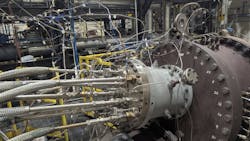GE Vernova Completes Validation Testing for 100% Hydrogen Mix in New Industrial Gas Turbines
Power manufacturer GE Vernova has completed a validation test campaign of an advanced Dry Low NOx (DLN) hydrogen combustion technology for B- and E-class gas turbines at Global Technology Center in Greenville, South Carolina.
The campaign was successfully operated on natural gas and hydrogen blends and on 100% hydrogen with dry emissions below 25 parts per million (ppm) nitrogen oxide (Nox). GE Vernova plans to provide the new DLN system for new and existing B- and E- gas turbines by 2026.
While combustion dynamics or noise is a challenge with hydrogen operation, the company says the prototype performed effectively in the category with relatively low levels, when operating on pure hydrogen. The technology was found to deliver higher availability and longer maintenance intervals in comparison to current DLN combustors operating on natural gas, crucial for industrial customers depending on gas turbines to power their operations reliably.
A new micromixer-based fuel air pre-mixer is the basis to the prototype combustor capability. GE Vernova’s research on micromixer technology started as part of collaboration with the U.S. Department of Energy.
Recent research conducted at GE Vernova’s Advanced Research Center in New York and at the Global Technology Center in Greenville focused on improving micromixer and axial fuel staging for hydrogen capability. This research culminated with the construction of a full size 6B DLN combustor prototype and testing in full scale conditions (pressure, flow, temperature) in the combustion test facility in Greenville, SC.
GE Vernova’s industrial gas turbines (B- and E-Class) are highly robust fleets, with an installed base of approximately 2,800 units. Hydrogen combustor options are available with ratings up to 100 percent hydrogen, however existing combustors use a diluent like water to manage emissions.
The new H2 DLN combustor technology is expected to present several benefits as compared to the existing systems, including a reported 4 to 7% increased efficnecy in combined cycle heat rate.
Hydrogen does not contain carbon in its formula so does not emit CO2 when combusted. To be created truly green hydrogen, it must be generated from electrolyzers powered by carbon-free resources such as wind, solar, hydro or nuclear.
